Professional Project: Relationship Between Firm Size and Exports
VerifiedAdded on 2020/05/16
|19
|4619
|142
Project
AI Summary
This professional project investigates the correlation between a firm's size and its export activities, as well as other factors that may influence export rates. The study utilizes secondary data collected from internet sources, scholarly articles, and journals to analyze this relationship. The research begins with an introduction that outlines the importance of exports in a country's economic development and reviews existing literature on the subject, particularly the commonly held belief that larger firms tend to export more. The methodology section details the use of secondary data collection, a random sampling technique, and a specified sample size. The data analysis and discussion section then delves into quantitative and qualitative analyses to assess the relationship between firm size and export rates, considering various factors. The project concludes with findings, conclusions, and recommendations based on the analysis of the data and the insights gathered from different researchers.
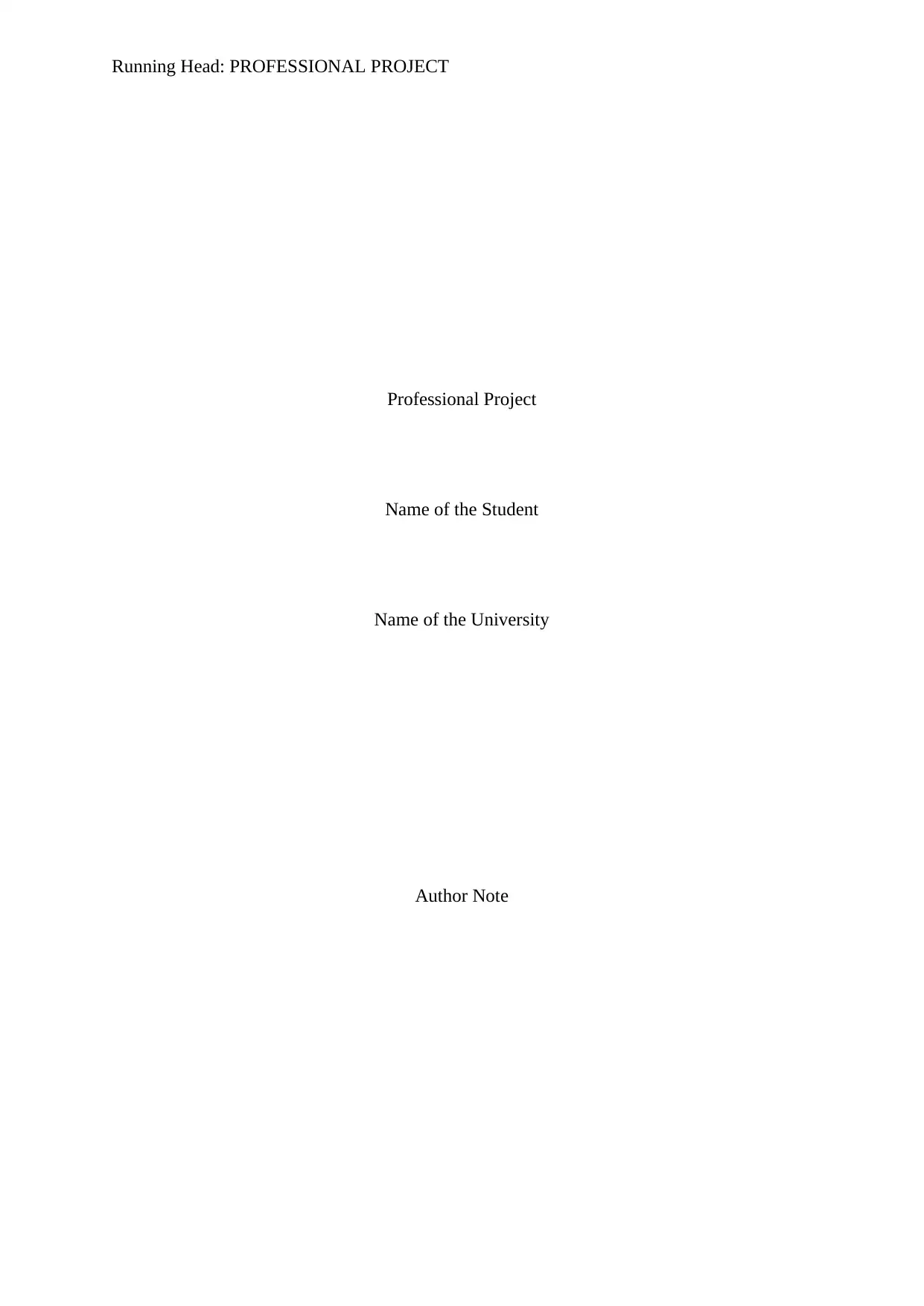
Running Head: PROFESSIONAL PROJECT
Professional Project
Name of the Student
Name of the University
Author Note
Professional Project
Name of the Student
Name of the University
Author Note
Paraphrase This Document
Need a fresh take? Get an instant paraphrase of this document with our AI Paraphraser
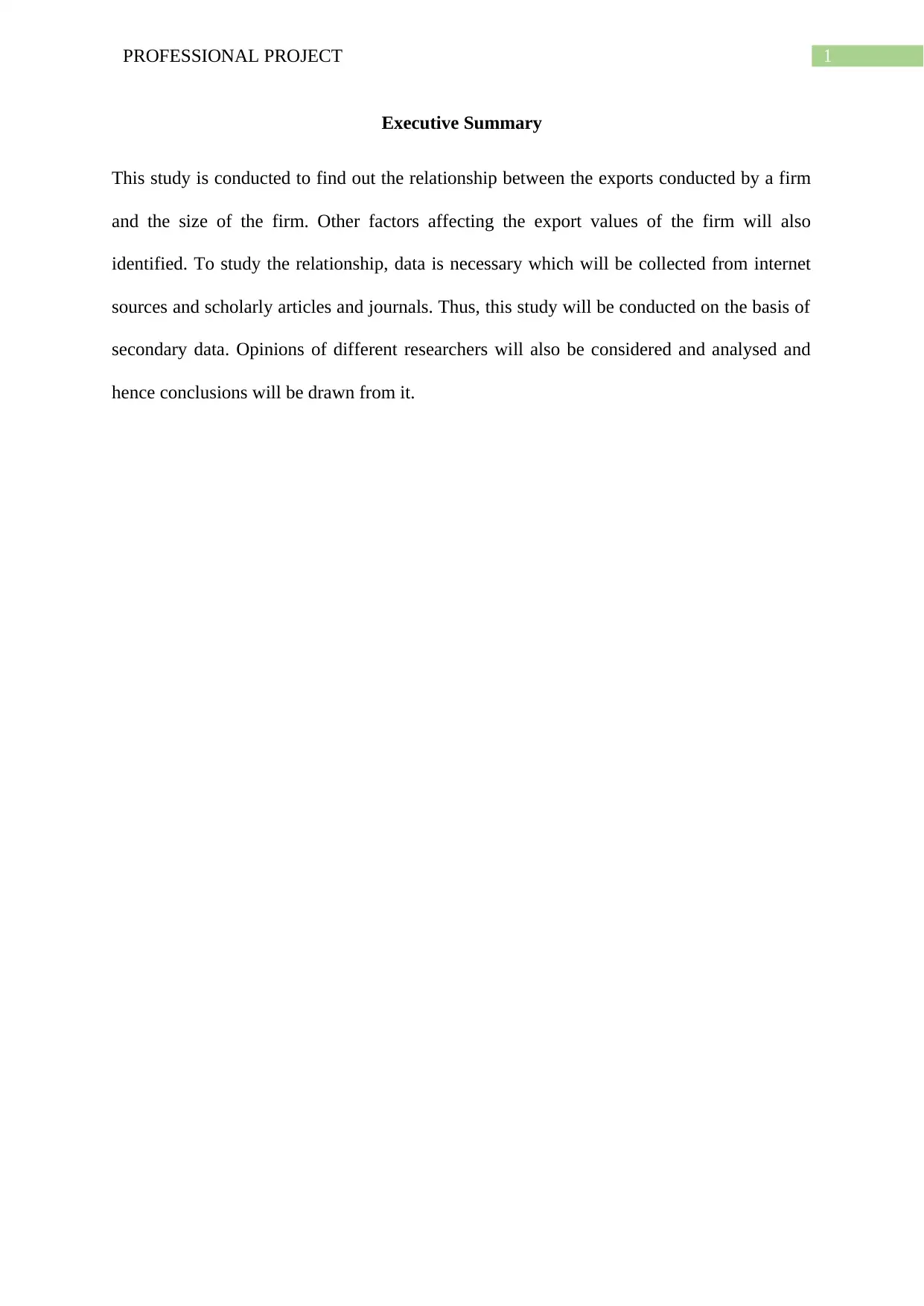
1PROFESSIONAL PROJECT
Executive Summary
This study is conducted to find out the relationship between the exports conducted by a firm
and the size of the firm. Other factors affecting the export values of the firm will also
identified. To study the relationship, data is necessary which will be collected from internet
sources and scholarly articles and journals. Thus, this study will be conducted on the basis of
secondary data. Opinions of different researchers will also be considered and analysed and
hence conclusions will be drawn from it.
Executive Summary
This study is conducted to find out the relationship between the exports conducted by a firm
and the size of the firm. Other factors affecting the export values of the firm will also
identified. To study the relationship, data is necessary which will be collected from internet
sources and scholarly articles and journals. Thus, this study will be conducted on the basis of
secondary data. Opinions of different researchers will also be considered and analysed and
hence conclusions will be drawn from it.
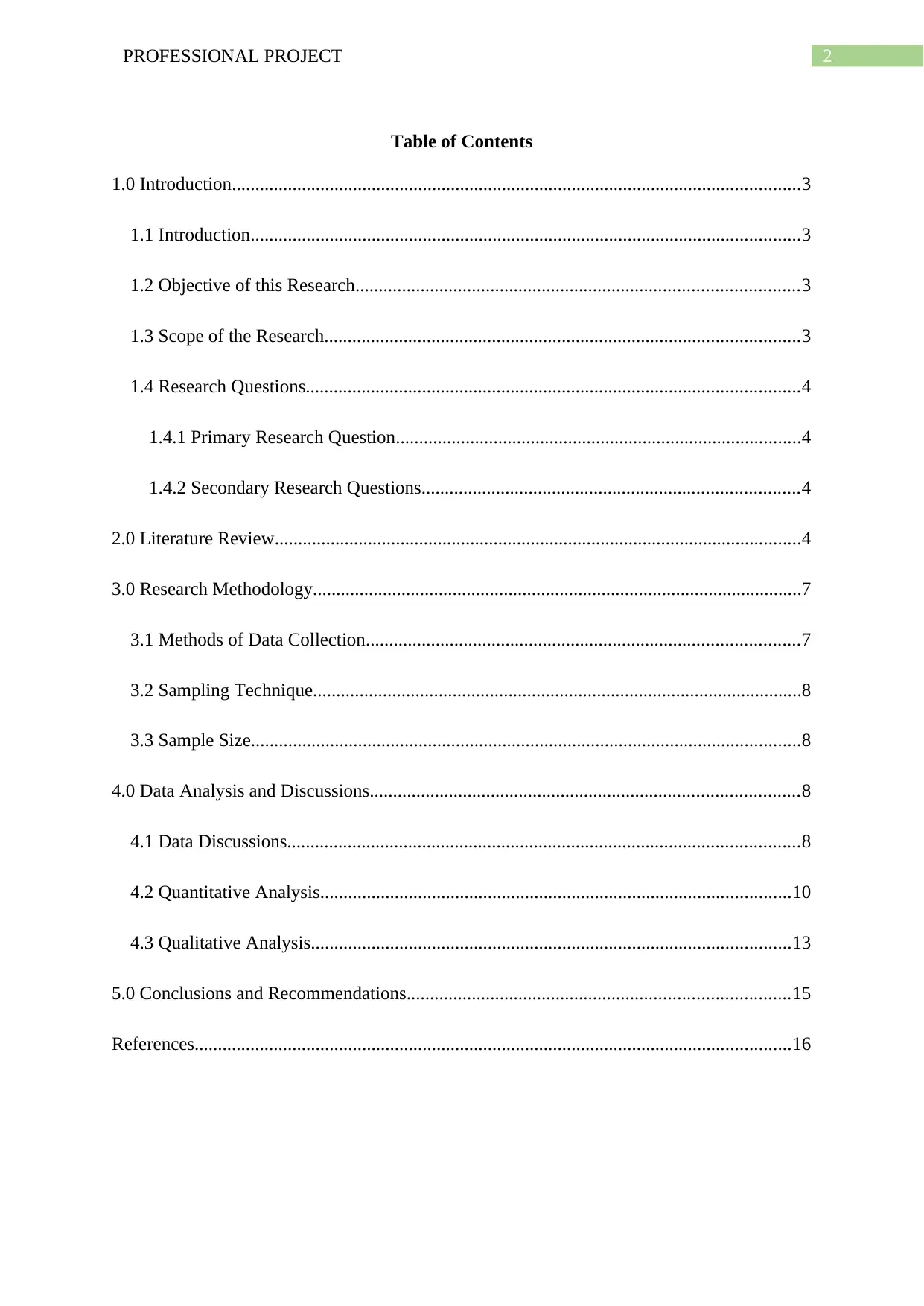
2PROFESSIONAL PROJECT
Table of Contents
1.0 Introduction..........................................................................................................................3
1.1 Introduction......................................................................................................................3
1.2 Objective of this Research...............................................................................................3
1.3 Scope of the Research......................................................................................................3
1.4 Research Questions..........................................................................................................4
1.4.1 Primary Research Question.......................................................................................4
1.4.2 Secondary Research Questions.................................................................................4
2.0 Literature Review.................................................................................................................4
3.0 Research Methodology.........................................................................................................7
3.1 Methods of Data Collection.............................................................................................7
3.2 Sampling Technique.........................................................................................................8
3.3 Sample Size......................................................................................................................8
4.0 Data Analysis and Discussions............................................................................................8
4.1 Data Discussions..............................................................................................................8
4.2 Quantitative Analysis.....................................................................................................10
4.3 Qualitative Analysis.......................................................................................................13
5.0 Conclusions and Recommendations..................................................................................15
References................................................................................................................................16
Table of Contents
1.0 Introduction..........................................................................................................................3
1.1 Introduction......................................................................................................................3
1.2 Objective of this Research...............................................................................................3
1.3 Scope of the Research......................................................................................................3
1.4 Research Questions..........................................................................................................4
1.4.1 Primary Research Question.......................................................................................4
1.4.2 Secondary Research Questions.................................................................................4
2.0 Literature Review.................................................................................................................4
3.0 Research Methodology.........................................................................................................7
3.1 Methods of Data Collection.............................................................................................7
3.2 Sampling Technique.........................................................................................................8
3.3 Sample Size......................................................................................................................8
4.0 Data Analysis and Discussions............................................................................................8
4.1 Data Discussions..............................................................................................................8
4.2 Quantitative Analysis.....................................................................................................10
4.3 Qualitative Analysis.......................................................................................................13
5.0 Conclusions and Recommendations..................................................................................15
References................................................................................................................................16
⊘ This is a preview!⊘
Do you want full access?
Subscribe today to unlock all pages.

Trusted by 1+ million students worldwide
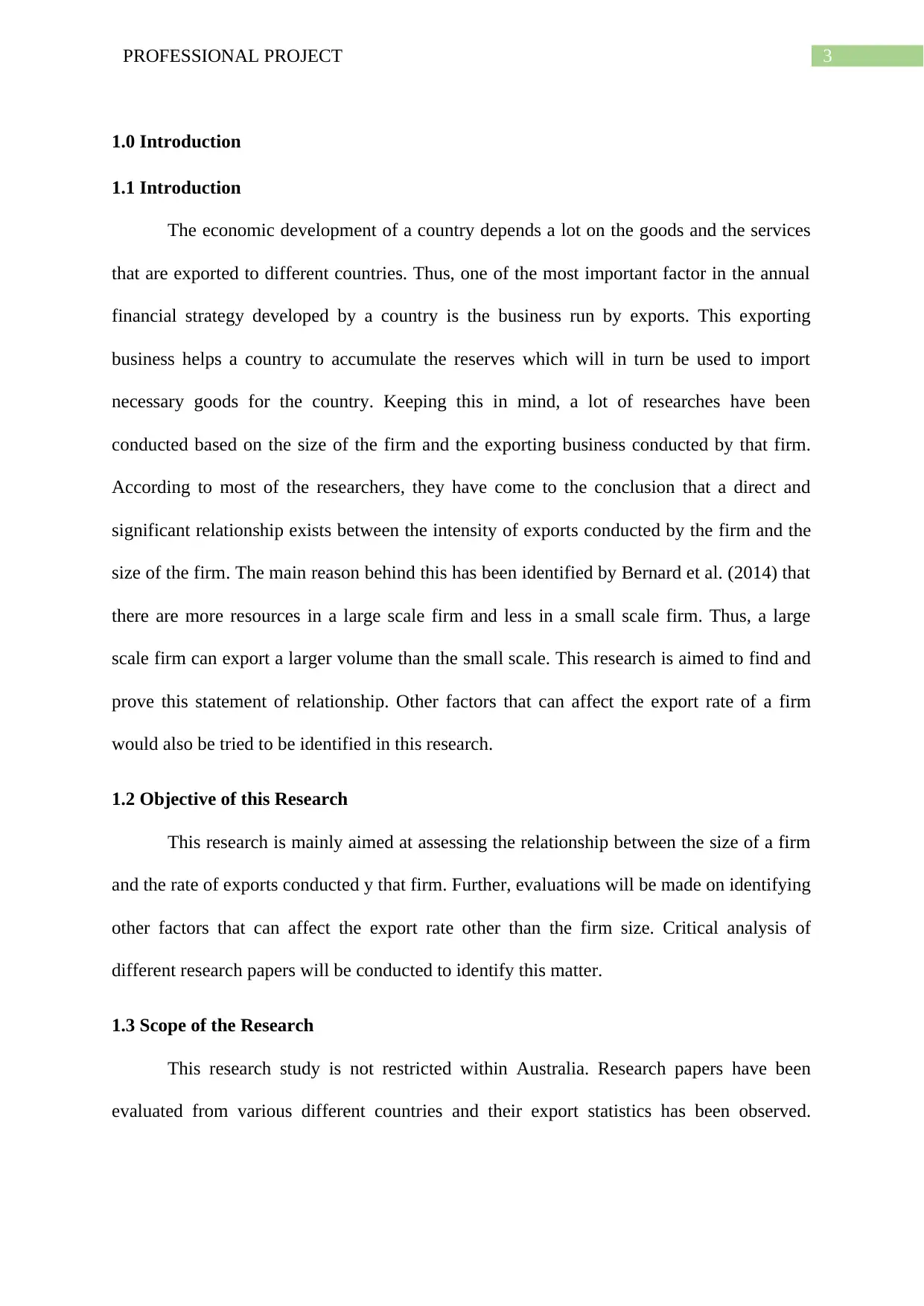
3PROFESSIONAL PROJECT
1.0 Introduction
1.1 Introduction
The economic development of a country depends a lot on the goods and the services
that are exported to different countries. Thus, one of the most important factor in the annual
financial strategy developed by a country is the business run by exports. This exporting
business helps a country to accumulate the reserves which will in turn be used to import
necessary goods for the country. Keeping this in mind, a lot of researches have been
conducted based on the size of the firm and the exporting business conducted by that firm.
According to most of the researchers, they have come to the conclusion that a direct and
significant relationship exists between the intensity of exports conducted by the firm and the
size of the firm. The main reason behind this has been identified by Bernard et al. (2014) that
there are more resources in a large scale firm and less in a small scale firm. Thus, a large
scale firm can export a larger volume than the small scale. This research is aimed to find and
prove this statement of relationship. Other factors that can affect the export rate of a firm
would also be tried to be identified in this research.
1.2 Objective of this Research
This research is mainly aimed at assessing the relationship between the size of a firm
and the rate of exports conducted y that firm. Further, evaluations will be made on identifying
other factors that can affect the export rate other than the firm size. Critical analysis of
different research papers will be conducted to identify this matter.
1.3 Scope of the Research
This research study is not restricted within Australia. Research papers have been
evaluated from various different countries and their export statistics has been observed.
1.0 Introduction
1.1 Introduction
The economic development of a country depends a lot on the goods and the services
that are exported to different countries. Thus, one of the most important factor in the annual
financial strategy developed by a country is the business run by exports. This exporting
business helps a country to accumulate the reserves which will in turn be used to import
necessary goods for the country. Keeping this in mind, a lot of researches have been
conducted based on the size of the firm and the exporting business conducted by that firm.
According to most of the researchers, they have come to the conclusion that a direct and
significant relationship exists between the intensity of exports conducted by the firm and the
size of the firm. The main reason behind this has been identified by Bernard et al. (2014) that
there are more resources in a large scale firm and less in a small scale firm. Thus, a large
scale firm can export a larger volume than the small scale. This research is aimed to find and
prove this statement of relationship. Other factors that can affect the export rate of a firm
would also be tried to be identified in this research.
1.2 Objective of this Research
This research is mainly aimed at assessing the relationship between the size of a firm
and the rate of exports conducted y that firm. Further, evaluations will be made on identifying
other factors that can affect the export rate other than the firm size. Critical analysis of
different research papers will be conducted to identify this matter.
1.3 Scope of the Research
This research study is not restricted within Australia. Research papers have been
evaluated from various different countries and their export statistics has been observed.
Paraphrase This Document
Need a fresh take? Get an instant paraphrase of this document with our AI Paraphraser
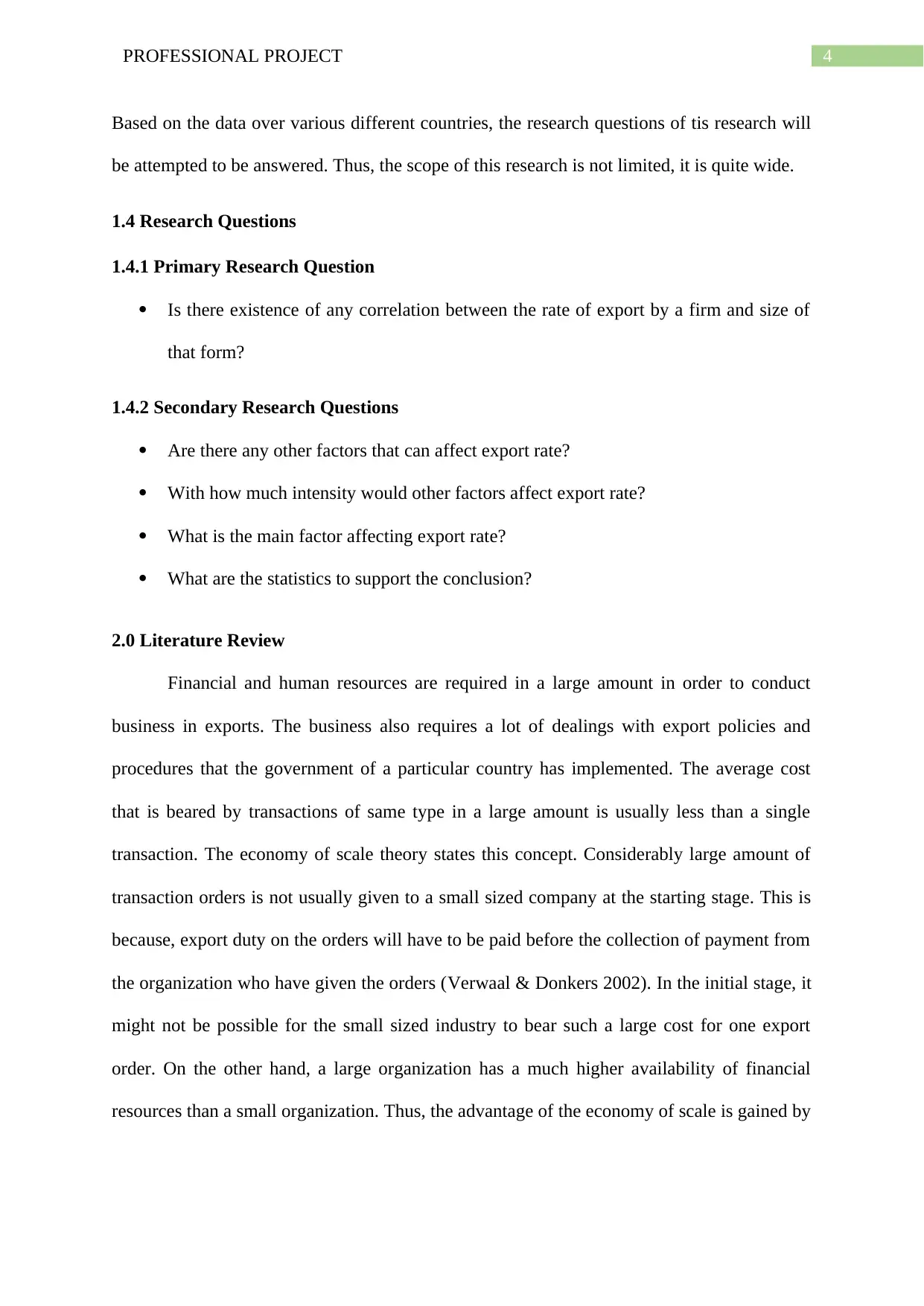
4PROFESSIONAL PROJECT
Based on the data over various different countries, the research questions of tis research will
be attempted to be answered. Thus, the scope of this research is not limited, it is quite wide.
1.4 Research Questions
1.4.1 Primary Research Question
Is there existence of any correlation between the rate of export by a firm and size of
that form?
1.4.2 Secondary Research Questions
Are there any other factors that can affect export rate?
With how much intensity would other factors affect export rate?
What is the main factor affecting export rate?
What are the statistics to support the conclusion?
2.0 Literature Review
Financial and human resources are required in a large amount in order to conduct
business in exports. The business also requires a lot of dealings with export policies and
procedures that the government of a particular country has implemented. The average cost
that is beared by transactions of same type in a large amount is usually less than a single
transaction. The economy of scale theory states this concept. Considerably large amount of
transaction orders is not usually given to a small sized company at the starting stage. This is
because, export duty on the orders will have to be paid before the collection of payment from
the organization who have given the orders (Verwaal & Donkers 2002). In the initial stage, it
might not be possible for the small sized industry to bear such a large cost for one export
order. On the other hand, a large organization has a much higher availability of financial
resources than a small organization. Thus, the advantage of the economy of scale is gained by
Based on the data over various different countries, the research questions of tis research will
be attempted to be answered. Thus, the scope of this research is not limited, it is quite wide.
1.4 Research Questions
1.4.1 Primary Research Question
Is there existence of any correlation between the rate of export by a firm and size of
that form?
1.4.2 Secondary Research Questions
Are there any other factors that can affect export rate?
With how much intensity would other factors affect export rate?
What is the main factor affecting export rate?
What are the statistics to support the conclusion?
2.0 Literature Review
Financial and human resources are required in a large amount in order to conduct
business in exports. The business also requires a lot of dealings with export policies and
procedures that the government of a particular country has implemented. The average cost
that is beared by transactions of same type in a large amount is usually less than a single
transaction. The economy of scale theory states this concept. Considerably large amount of
transaction orders is not usually given to a small sized company at the starting stage. This is
because, export duty on the orders will have to be paid before the collection of payment from
the organization who have given the orders (Verwaal & Donkers 2002). In the initial stage, it
might not be possible for the small sized industry to bear such a large cost for one export
order. On the other hand, a large organization has a much higher availability of financial
resources than a small organization. Thus, the advantage of the economy of scale is gained by
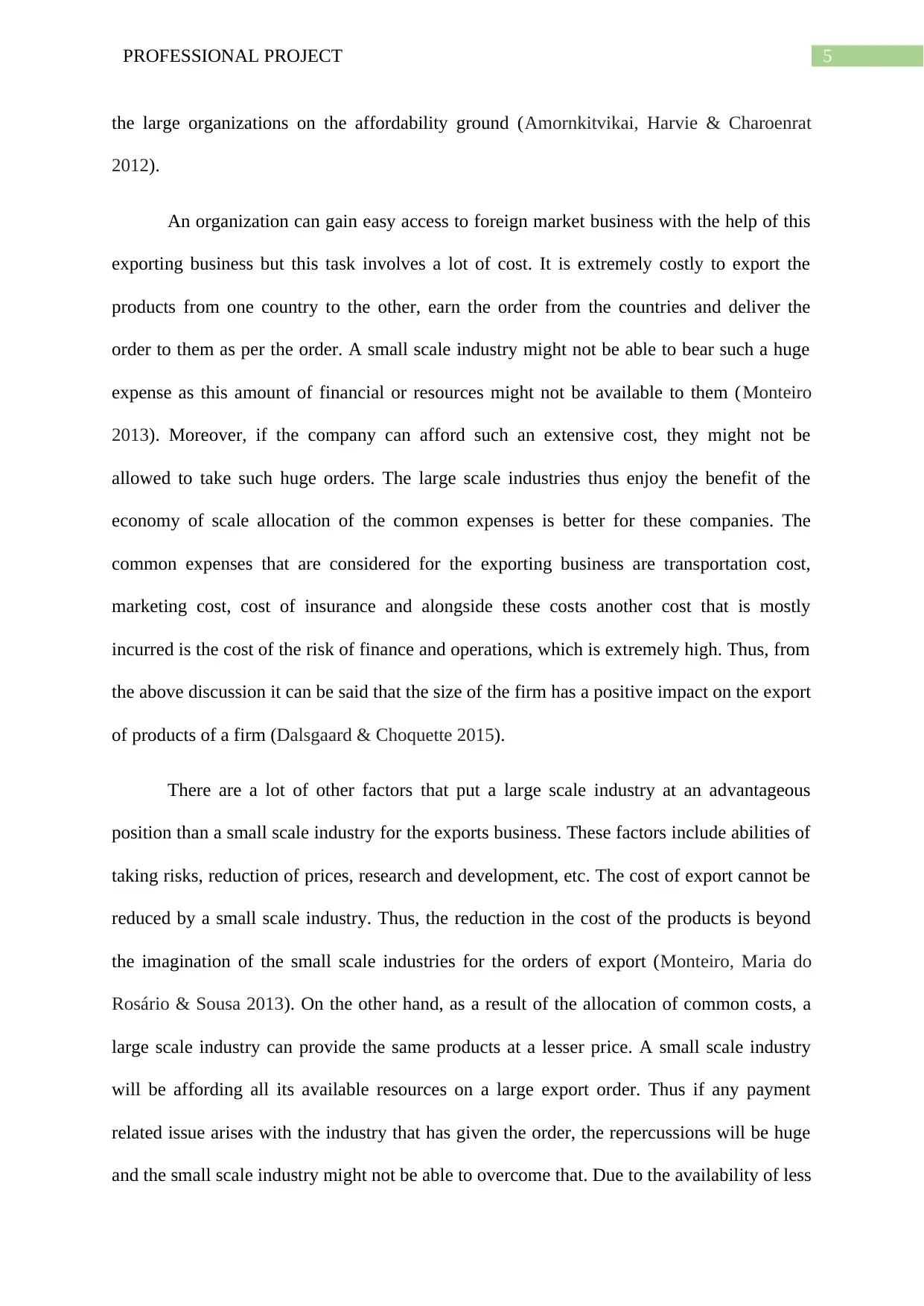
5PROFESSIONAL PROJECT
the large organizations on the affordability ground (Amornkitvikai, Harvie & Charoenrat
2012).
An organization can gain easy access to foreign market business with the help of this
exporting business but this task involves a lot of cost. It is extremely costly to export the
products from one country to the other, earn the order from the countries and deliver the
order to them as per the order. A small scale industry might not be able to bear such a huge
expense as this amount of financial or resources might not be available to them (Monteiro
2013). Moreover, if the company can afford such an extensive cost, they might not be
allowed to take such huge orders. The large scale industries thus enjoy the benefit of the
economy of scale allocation of the common expenses is better for these companies. The
common expenses that are considered for the exporting business are transportation cost,
marketing cost, cost of insurance and alongside these costs another cost that is mostly
incurred is the cost of the risk of finance and operations, which is extremely high. Thus, from
the above discussion it can be said that the size of the firm has a positive impact on the export
of products of a firm (Dalsgaard & Choquette 2015).
There are a lot of other factors that put a large scale industry at an advantageous
position than a small scale industry for the exports business. These factors include abilities of
taking risks, reduction of prices, research and development, etc. The cost of export cannot be
reduced by a small scale industry. Thus, the reduction in the cost of the products is beyond
the imagination of the small scale industries for the orders of export (Monteiro, Maria do
Rosário & Sousa 2013). On the other hand, as a result of the allocation of common costs, a
large scale industry can provide the same products at a lesser price. A small scale industry
will be affording all its available resources on a large export order. Thus if any payment
related issue arises with the industry that has given the order, the repercussions will be huge
and the small scale industry might not be able to overcome that. Due to the availability of less
the large organizations on the affordability ground (Amornkitvikai, Harvie & Charoenrat
2012).
An organization can gain easy access to foreign market business with the help of this
exporting business but this task involves a lot of cost. It is extremely costly to export the
products from one country to the other, earn the order from the countries and deliver the
order to them as per the order. A small scale industry might not be able to bear such a huge
expense as this amount of financial or resources might not be available to them (Monteiro
2013). Moreover, if the company can afford such an extensive cost, they might not be
allowed to take such huge orders. The large scale industries thus enjoy the benefit of the
economy of scale allocation of the common expenses is better for these companies. The
common expenses that are considered for the exporting business are transportation cost,
marketing cost, cost of insurance and alongside these costs another cost that is mostly
incurred is the cost of the risk of finance and operations, which is extremely high. Thus, from
the above discussion it can be said that the size of the firm has a positive impact on the export
of products of a firm (Dalsgaard & Choquette 2015).
There are a lot of other factors that put a large scale industry at an advantageous
position than a small scale industry for the exports business. These factors include abilities of
taking risks, reduction of prices, research and development, etc. The cost of export cannot be
reduced by a small scale industry. Thus, the reduction in the cost of the products is beyond
the imagination of the small scale industries for the orders of export (Monteiro, Maria do
Rosário & Sousa 2013). On the other hand, as a result of the allocation of common costs, a
large scale industry can provide the same products at a lesser price. A small scale industry
will be affording all its available resources on a large export order. Thus if any payment
related issue arises with the industry that has given the order, the repercussions will be huge
and the small scale industry might not be able to overcome that. Due to the availability of less
⊘ This is a preview!⊘
Do you want full access?
Subscribe today to unlock all pages.

Trusted by 1+ million students worldwide
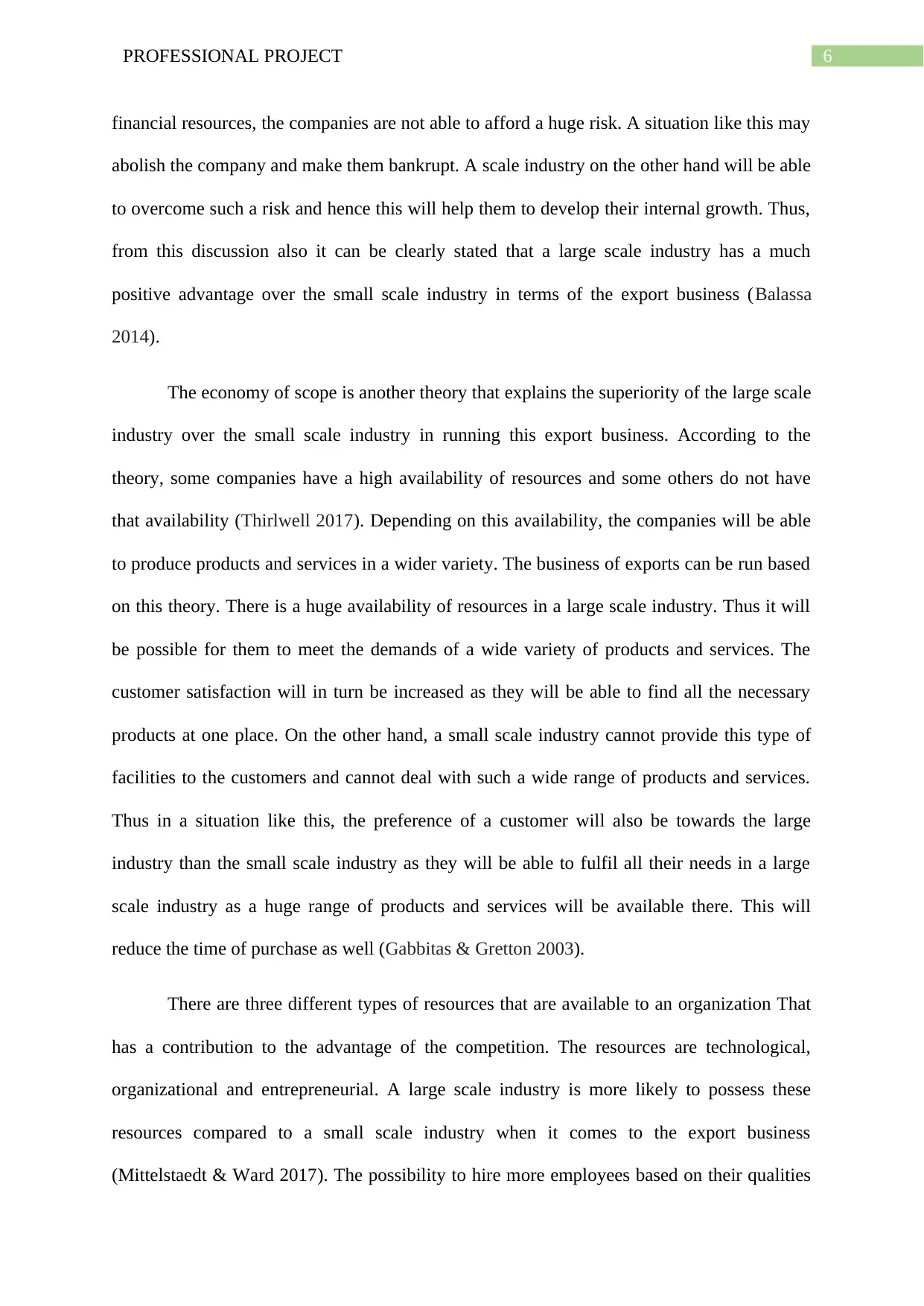
6PROFESSIONAL PROJECT
financial resources, the companies are not able to afford a huge risk. A situation like this may
abolish the company and make them bankrupt. A scale industry on the other hand will be able
to overcome such a risk and hence this will help them to develop their internal growth. Thus,
from this discussion also it can be clearly stated that a large scale industry has a much
positive advantage over the small scale industry in terms of the export business (Balassa
2014).
The economy of scope is another theory that explains the superiority of the large scale
industry over the small scale industry in running this export business. According to the
theory, some companies have a high availability of resources and some others do not have
that availability (Thirlwell 2017). Depending on this availability, the companies will be able
to produce products and services in a wider variety. The business of exports can be run based
on this theory. There is a huge availability of resources in a large scale industry. Thus it will
be possible for them to meet the demands of a wide variety of products and services. The
customer satisfaction will in turn be increased as they will be able to find all the necessary
products at one place. On the other hand, a small scale industry cannot provide this type of
facilities to the customers and cannot deal with such a wide range of products and services.
Thus in a situation like this, the preference of a customer will also be towards the large
industry than the small scale industry as they will be able to fulfil all their needs in a large
scale industry as a huge range of products and services will be available there. This will
reduce the time of purchase as well (Gabbitas & Gretton 2003).
There are three different types of resources that are available to an organization That
has a contribution to the advantage of the competition. The resources are technological,
organizational and entrepreneurial. A large scale industry is more likely to possess these
resources compared to a small scale industry when it comes to the export business
(Mittelstaedt & Ward 2017). The possibility to hire more employees based on their qualities
financial resources, the companies are not able to afford a huge risk. A situation like this may
abolish the company and make them bankrupt. A scale industry on the other hand will be able
to overcome such a risk and hence this will help them to develop their internal growth. Thus,
from this discussion also it can be clearly stated that a large scale industry has a much
positive advantage over the small scale industry in terms of the export business (Balassa
2014).
The economy of scope is another theory that explains the superiority of the large scale
industry over the small scale industry in running this export business. According to the
theory, some companies have a high availability of resources and some others do not have
that availability (Thirlwell 2017). Depending on this availability, the companies will be able
to produce products and services in a wider variety. The business of exports can be run based
on this theory. There is a huge availability of resources in a large scale industry. Thus it will
be possible for them to meet the demands of a wide variety of products and services. The
customer satisfaction will in turn be increased as they will be able to find all the necessary
products at one place. On the other hand, a small scale industry cannot provide this type of
facilities to the customers and cannot deal with such a wide range of products and services.
Thus in a situation like this, the preference of a customer will also be towards the large
industry than the small scale industry as they will be able to fulfil all their needs in a large
scale industry as a huge range of products and services will be available there. This will
reduce the time of purchase as well (Gabbitas & Gretton 2003).
There are three different types of resources that are available to an organization That
has a contribution to the advantage of the competition. The resources are technological,
organizational and entrepreneurial. A large scale industry is more likely to possess these
resources compared to a small scale industry when it comes to the export business
(Mittelstaedt & Ward 2017). The possibility to hire more employees based on their qualities
Paraphrase This Document
Need a fresh take? Get an instant paraphrase of this document with our AI Paraphraser
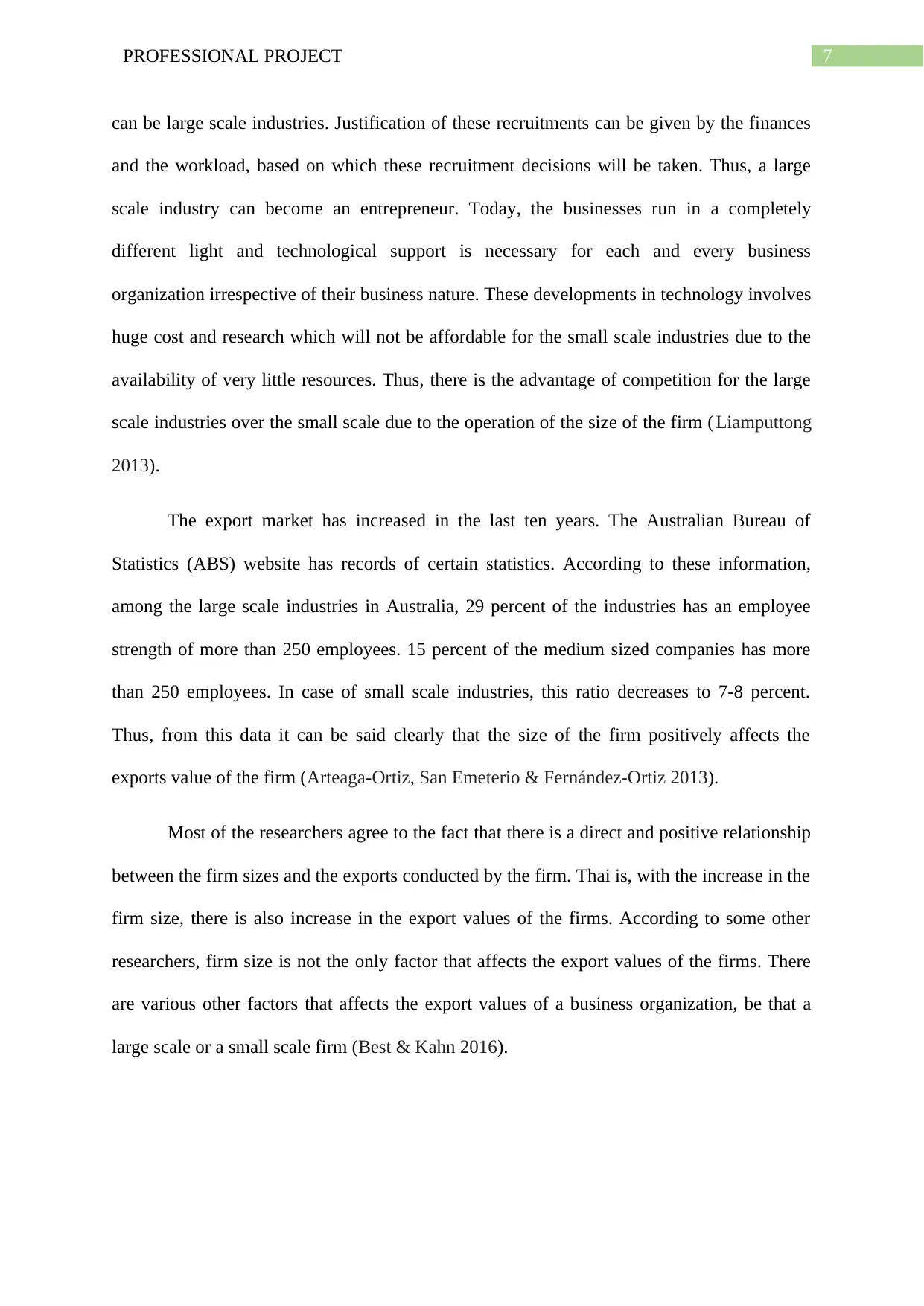
7PROFESSIONAL PROJECT
can be large scale industries. Justification of these recruitments can be given by the finances
and the workload, based on which these recruitment decisions will be taken. Thus, a large
scale industry can become an entrepreneur. Today, the businesses run in a completely
different light and technological support is necessary for each and every business
organization irrespective of their business nature. These developments in technology involves
huge cost and research which will not be affordable for the small scale industries due to the
availability of very little resources. Thus, there is the advantage of competition for the large
scale industries over the small scale due to the operation of the size of the firm (Liamputtong
2013).
The export market has increased in the last ten years. The Australian Bureau of
Statistics (ABS) website has records of certain statistics. According to these information,
among the large scale industries in Australia, 29 percent of the industries has an employee
strength of more than 250 employees. 15 percent of the medium sized companies has more
than 250 employees. In case of small scale industries, this ratio decreases to 7-8 percent.
Thus, from this data it can be said clearly that the size of the firm positively affects the
exports value of the firm (Arteaga-Ortiz, San Emeterio & Fernández-Ortiz 2013).
Most of the researchers agree to the fact that there is a direct and positive relationship
between the firm sizes and the exports conducted by the firm. Thai is, with the increase in the
firm size, there is also increase in the export values of the firms. According to some other
researchers, firm size is not the only factor that affects the export values of the firms. There
are various other factors that affects the export values of a business organization, be that a
large scale or a small scale firm (Best & Kahn 2016).
can be large scale industries. Justification of these recruitments can be given by the finances
and the workload, based on which these recruitment decisions will be taken. Thus, a large
scale industry can become an entrepreneur. Today, the businesses run in a completely
different light and technological support is necessary for each and every business
organization irrespective of their business nature. These developments in technology involves
huge cost and research which will not be affordable for the small scale industries due to the
availability of very little resources. Thus, there is the advantage of competition for the large
scale industries over the small scale due to the operation of the size of the firm (Liamputtong
2013).
The export market has increased in the last ten years. The Australian Bureau of
Statistics (ABS) website has records of certain statistics. According to these information,
among the large scale industries in Australia, 29 percent of the industries has an employee
strength of more than 250 employees. 15 percent of the medium sized companies has more
than 250 employees. In case of small scale industries, this ratio decreases to 7-8 percent.
Thus, from this data it can be said clearly that the size of the firm positively affects the
exports value of the firm (Arteaga-Ortiz, San Emeterio & Fernández-Ortiz 2013).
Most of the researchers agree to the fact that there is a direct and positive relationship
between the firm sizes and the exports conducted by the firm. Thai is, with the increase in the
firm size, there is also increase in the export values of the firms. According to some other
researchers, firm size is not the only factor that affects the export values of the firms. There
are various other factors that affects the export values of a business organization, be that a
large scale or a small scale firm (Best & Kahn 2016).
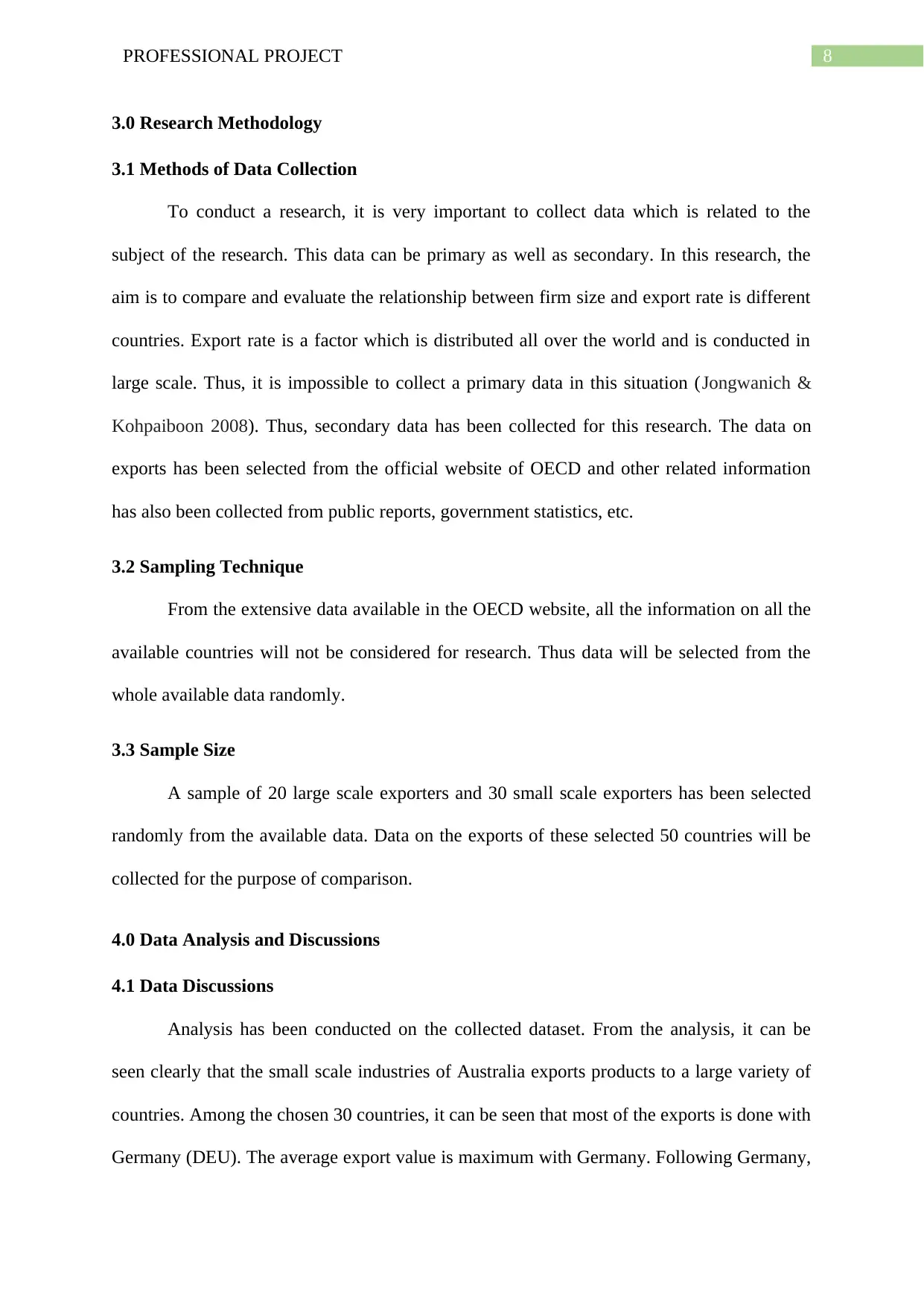
8PROFESSIONAL PROJECT
3.0 Research Methodology
3.1 Methods of Data Collection
To conduct a research, it is very important to collect data which is related to the
subject of the research. This data can be primary as well as secondary. In this research, the
aim is to compare and evaluate the relationship between firm size and export rate is different
countries. Export rate is a factor which is distributed all over the world and is conducted in
large scale. Thus, it is impossible to collect a primary data in this situation (Jongwanich &
Kohpaiboon 2008). Thus, secondary data has been collected for this research. The data on
exports has been selected from the official website of OECD and other related information
has also been collected from public reports, government statistics, etc.
3.2 Sampling Technique
From the extensive data available in the OECD website, all the information on all the
available countries will not be considered for research. Thus data will be selected from the
whole available data randomly.
3.3 Sample Size
A sample of 20 large scale exporters and 30 small scale exporters has been selected
randomly from the available data. Data on the exports of these selected 50 countries will be
collected for the purpose of comparison.
4.0 Data Analysis and Discussions
4.1 Data Discussions
Analysis has been conducted on the collected dataset. From the analysis, it can be
seen clearly that the small scale industries of Australia exports products to a large variety of
countries. Among the chosen 30 countries, it can be seen that most of the exports is done with
Germany (DEU). The average export value is maximum with Germany. Following Germany,
3.0 Research Methodology
3.1 Methods of Data Collection
To conduct a research, it is very important to collect data which is related to the
subject of the research. This data can be primary as well as secondary. In this research, the
aim is to compare and evaluate the relationship between firm size and export rate is different
countries. Export rate is a factor which is distributed all over the world and is conducted in
large scale. Thus, it is impossible to collect a primary data in this situation (Jongwanich &
Kohpaiboon 2008). Thus, secondary data has been collected for this research. The data on
exports has been selected from the official website of OECD and other related information
has also been collected from public reports, government statistics, etc.
3.2 Sampling Technique
From the extensive data available in the OECD website, all the information on all the
available countries will not be considered for research. Thus data will be selected from the
whole available data randomly.
3.3 Sample Size
A sample of 20 large scale exporters and 30 small scale exporters has been selected
randomly from the available data. Data on the exports of these selected 50 countries will be
collected for the purpose of comparison.
4.0 Data Analysis and Discussions
4.1 Data Discussions
Analysis has been conducted on the collected dataset. From the analysis, it can be
seen clearly that the small scale industries of Australia exports products to a large variety of
countries. Among the chosen 30 countries, it can be seen that most of the exports is done with
Germany (DEU). The average export value is maximum with Germany. Following Germany,
⊘ This is a preview!⊘
Do you want full access?
Subscribe today to unlock all pages.

Trusted by 1+ million students worldwide
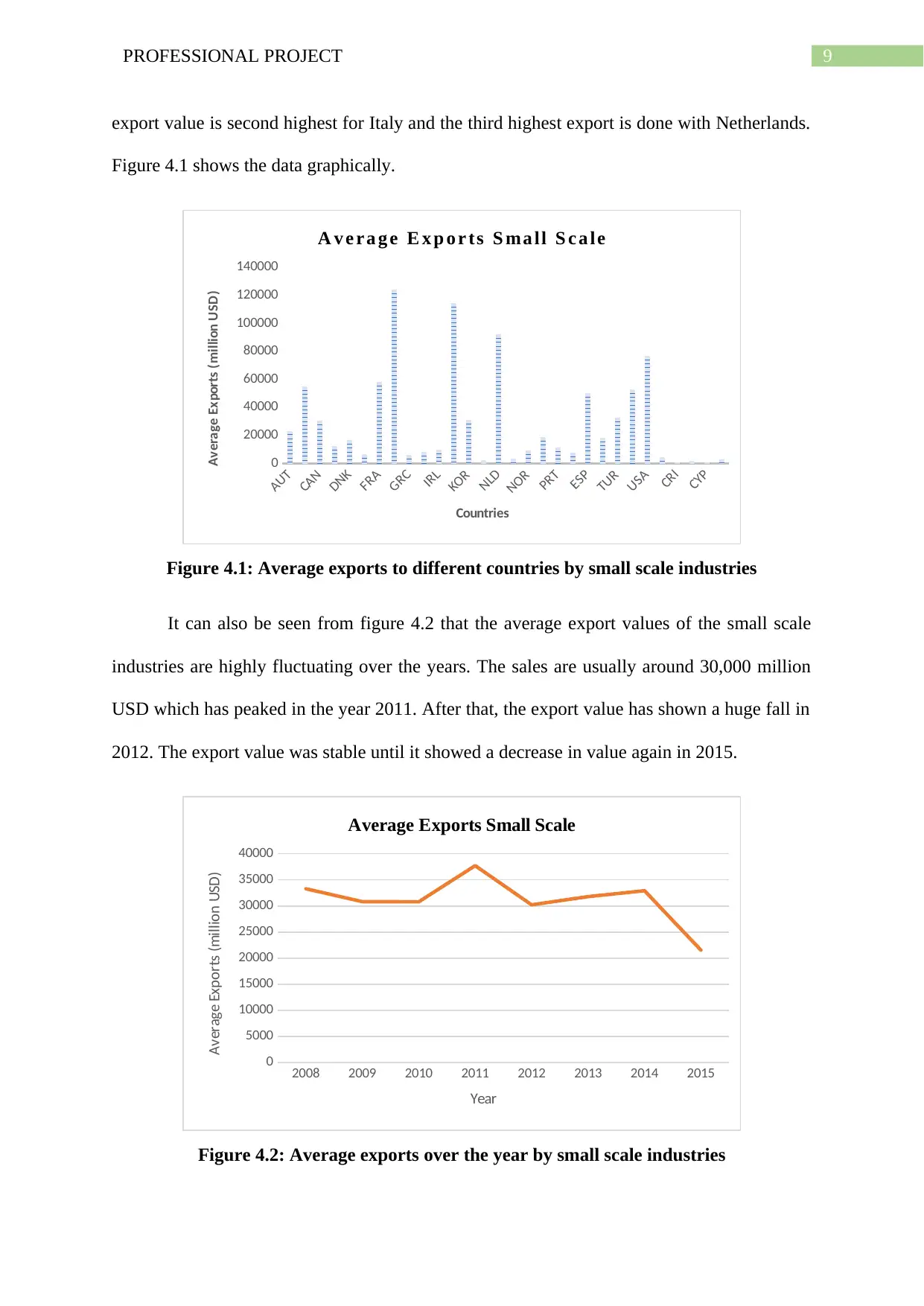
9PROFESSIONAL PROJECT
export value is second highest for Italy and the third highest export is done with Netherlands.
Figure 4.1 shows the data graphically.
AUT
CAN
DNK
FRA
GRC
IRL
KOR
NLD
NOR
PRT
ESP
TUR
USA
CRI
CYP
0
20000
40000
60000
80000
100000
120000
140000
A v e r a g e E x p o r ts S ma ll S c a le
Countries
Average Exports (million USD)
Figure 4.1: Average exports to different countries by small scale industries
It can also be seen from figure 4.2 that the average export values of the small scale
industries are highly fluctuating over the years. The sales are usually around 30,000 million
USD which has peaked in the year 2011. After that, the export value has shown a huge fall in
2012. The export value was stable until it showed a decrease in value again in 2015.
2008 2009 2010 2011 2012 2013 2014 2015
0
5000
10000
15000
20000
25000
30000
35000
40000
Average Exports Small Scale
Year
Average Exports (million USD)
Figure 4.2: Average exports over the year by small scale industries
export value is second highest for Italy and the third highest export is done with Netherlands.
Figure 4.1 shows the data graphically.
AUT
CAN
DNK
FRA
GRC
IRL
KOR
NLD
NOR
PRT
ESP
TUR
USA
CRI
CYP
0
20000
40000
60000
80000
100000
120000
140000
A v e r a g e E x p o r ts S ma ll S c a le
Countries
Average Exports (million USD)
Figure 4.1: Average exports to different countries by small scale industries
It can also be seen from figure 4.2 that the average export values of the small scale
industries are highly fluctuating over the years. The sales are usually around 30,000 million
USD which has peaked in the year 2011. After that, the export value has shown a huge fall in
2012. The export value was stable until it showed a decrease in value again in 2015.
2008 2009 2010 2011 2012 2013 2014 2015
0
5000
10000
15000
20000
25000
30000
35000
40000
Average Exports Small Scale
Year
Average Exports (million USD)
Figure 4.2: Average exports over the year by small scale industries
Paraphrase This Document
Need a fresh take? Get an instant paraphrase of this document with our AI Paraphraser
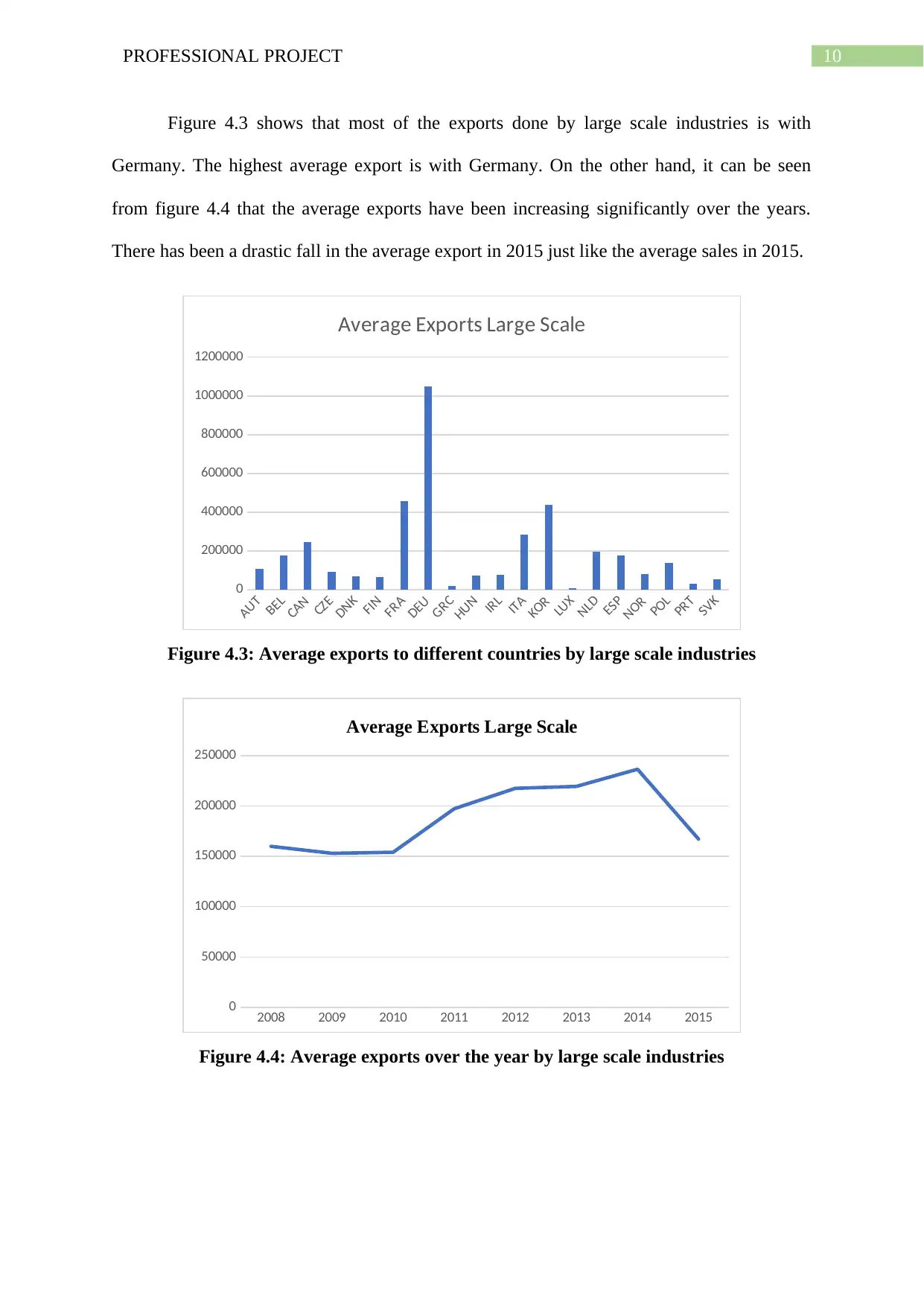
10PROFESSIONAL PROJECT
Figure 4.3 shows that most of the exports done by large scale industries is with
Germany. The highest average export is with Germany. On the other hand, it can be seen
from figure 4.4 that the average exports have been increasing significantly over the years.
There has been a drastic fall in the average export in 2015 just like the average sales in 2015.
AUT
BEL
CAN
CZE
DNK
FIN
FRA
DEU
GRC
HUN
IRL
ITA
KOR
LUX
NLD
ESP
NOR
POL
PRT
SVK
0
200000
400000
600000
800000
1000000
1200000
Average Exports Large Scale
Figure 4.3: Average exports to different countries by large scale industries
2008 2009 2010 2011 2012 2013 2014 2015
0
50000
100000
150000
200000
250000
Average Exports Large Scale
Figure 4.4: Average exports over the year by large scale industries
Figure 4.3 shows that most of the exports done by large scale industries is with
Germany. The highest average export is with Germany. On the other hand, it can be seen
from figure 4.4 that the average exports have been increasing significantly over the years.
There has been a drastic fall in the average export in 2015 just like the average sales in 2015.
AUT
BEL
CAN
CZE
DNK
FIN
FRA
DEU
GRC
HUN
IRL
ITA
KOR
LUX
NLD
ESP
NOR
POL
PRT
SVK
0
200000
400000
600000
800000
1000000
1200000
Average Exports Large Scale
Figure 4.3: Average exports to different countries by large scale industries
2008 2009 2010 2011 2012 2013 2014 2015
0
50000
100000
150000
200000
250000
Average Exports Large Scale
Figure 4.4: Average exports over the year by large scale industries
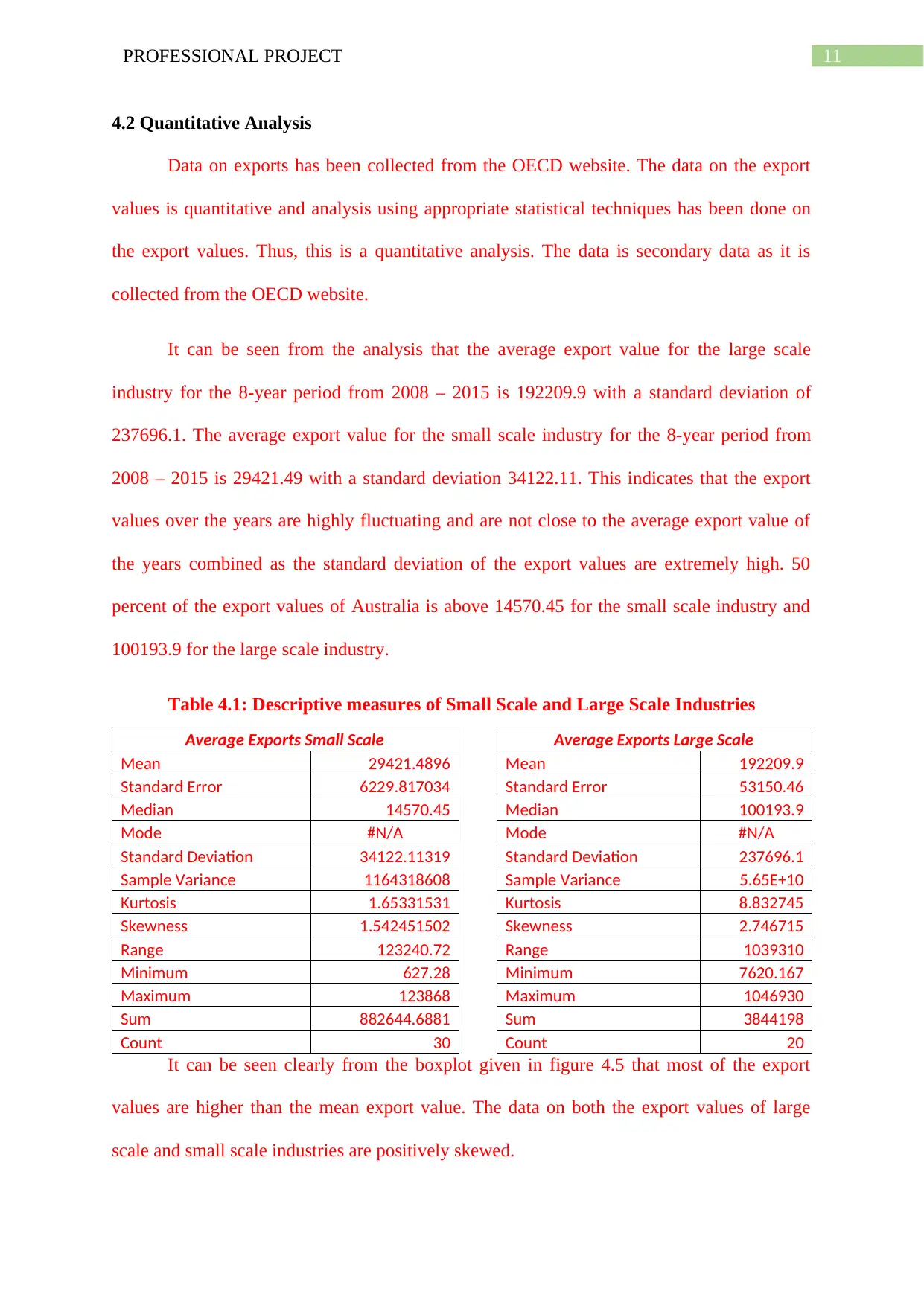
11PROFESSIONAL PROJECT
4.2 Quantitative Analysis
Data on exports has been collected from the OECD website. The data on the export
values is quantitative and analysis using appropriate statistical techniques has been done on
the export values. Thus, this is a quantitative analysis. The data is secondary data as it is
collected from the OECD website.
It can be seen from the analysis that the average export value for the large scale
industry for the 8-year period from 2008 – 2015 is 192209.9 with a standard deviation of
237696.1. The average export value for the small scale industry for the 8-year period from
2008 – 2015 is 29421.49 with a standard deviation 34122.11. This indicates that the export
values over the years are highly fluctuating and are not close to the average export value of
the years combined as the standard deviation of the export values are extremely high. 50
percent of the export values of Australia is above 14570.45 for the small scale industry and
100193.9 for the large scale industry.
Table 4.1: Descriptive measures of Small Scale and Large Scale Industries
Average Exports Small Scale Average Exports Large Scale
Mean 29421.4896 Mean 192209.9
Standard Error 6229.817034 Standard Error 53150.46
Median 14570.45 Median 100193.9
Mode #N/A Mode #N/A
Standard Deviation 34122.11319 Standard Deviation 237696.1
Sample Variance 1164318608 Sample Variance 5.65E+10
Kurtosis 1.65331531 Kurtosis 8.832745
Skewness 1.542451502 Skewness 2.746715
Range 123240.72 Range 1039310
Minimum 627.28 Minimum 7620.167
Maximum 123868 Maximum 1046930
Sum 882644.6881 Sum 3844198
Count 30 Count 20
It can be seen clearly from the boxplot given in figure 4.5 that most of the export
values are higher than the mean export value. The data on both the export values of large
scale and small scale industries are positively skewed.
4.2 Quantitative Analysis
Data on exports has been collected from the OECD website. The data on the export
values is quantitative and analysis using appropriate statistical techniques has been done on
the export values. Thus, this is a quantitative analysis. The data is secondary data as it is
collected from the OECD website.
It can be seen from the analysis that the average export value for the large scale
industry for the 8-year period from 2008 – 2015 is 192209.9 with a standard deviation of
237696.1. The average export value for the small scale industry for the 8-year period from
2008 – 2015 is 29421.49 with a standard deviation 34122.11. This indicates that the export
values over the years are highly fluctuating and are not close to the average export value of
the years combined as the standard deviation of the export values are extremely high. 50
percent of the export values of Australia is above 14570.45 for the small scale industry and
100193.9 for the large scale industry.
Table 4.1: Descriptive measures of Small Scale and Large Scale Industries
Average Exports Small Scale Average Exports Large Scale
Mean 29421.4896 Mean 192209.9
Standard Error 6229.817034 Standard Error 53150.46
Median 14570.45 Median 100193.9
Mode #N/A Mode #N/A
Standard Deviation 34122.11319 Standard Deviation 237696.1
Sample Variance 1164318608 Sample Variance 5.65E+10
Kurtosis 1.65331531 Kurtosis 8.832745
Skewness 1.542451502 Skewness 2.746715
Range 123240.72 Range 1039310
Minimum 627.28 Minimum 7620.167
Maximum 123868 Maximum 1046930
Sum 882644.6881 Sum 3844198
Count 30 Count 20
It can be seen clearly from the boxplot given in figure 4.5 that most of the export
values are higher than the mean export value. The data on both the export values of large
scale and small scale industries are positively skewed.
⊘ This is a preview!⊘
Do you want full access?
Subscribe today to unlock all pages.

Trusted by 1+ million students worldwide
1 out of 19
Related Documents
Your All-in-One AI-Powered Toolkit for Academic Success.
+13062052269
info@desklib.com
Available 24*7 on WhatsApp / Email
![[object Object]](/_next/static/media/star-bottom.7253800d.svg)
Unlock your academic potential
Copyright © 2020–2025 A2Z Services. All Rights Reserved. Developed and managed by ZUCOL.




